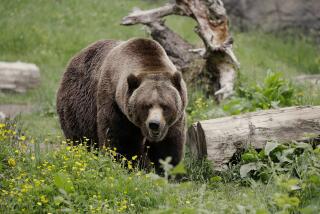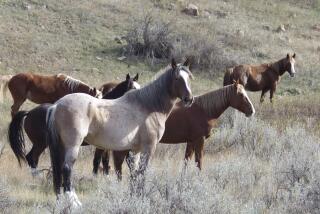Wild horse preserves proposed for Midwest and East
WASHINGTON — Thousands of mustangs that roam the West would be moved to preserves in the Midwest and East to protect the wild horses and the rangelands that support them, Interior Secretary Ken Salazar said Wednesday.
The plan would not require killing any wild horses, he said. Interior Department officials had warned in recent months that slaughtering some wild horses and burros might be necessary to combat the rising cost of maintaining them.
“We have a huge problem -- out-of-control populations of wild horses and burros on our public lands,” Salazar said in a conference call with reporters. “The problem has been growing and simmering over time, and it’s time for us to do something about it that protects the horses, the public lands and the taxpayers.”
With no natural predators left in their habitat, the wild horses and burros have grown from 25,000 in 1971 to 69,000 today. They compete with cattle and wildlife for food and water.
The Bureau of Land Management says the range can support about 26,600 wild horses and burros. Today, about 37,000 wild horses and burros roam on federal land in Nevada, California, Wyoming and other Western states -- a difference of 10,400. An additional 32,000 horses and burros are cared for in corrals and pastures in Kansas, Oklahoma and South Dakota.
The wild horse program, run by the BLM, cost about $50 million this year, officials said, up from $36 million last year. The bureau rounds up thousands of the animals annually but has had a hard time finding buyers in recent years. Federal law prohibits sending the horses to slaughter.
Animal advocates including Wayne Pacelle, chief executive of the Humane Society of the United States, praised the plan. But American Horse Defense Fund President Shelley Sawhook said she was skeptical. She blamed the herd’s predicament on the fact that officials had taken 19 million acres of federal habitat away from the horses and burros.
Salazar and BLM Director Bob Abbey urged Congress to authorize seven wild horse preserves -- including two owned and operated by the BLM. The agency would work with private groups on the remaining reserves, which would be somewhere in the Midwest and East.
Salazar did not identify where the preserves would be, but he said the two federally owned preserves would cost about $92 million.
The seven preserves would hold about 25,000 horses. Many of those that remain on the range would be neutered, Salazar said.
BLM spokesman Tom Gorey said the preserves should be accessible to the public.
“We think there is real potential for ecotourism,” he said. “Everybody loves horses.”
More to Read
Sign up for Essential California
The most important California stories and recommendations in your inbox every morning.
You may occasionally receive promotional content from the Los Angeles Times.










